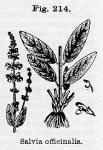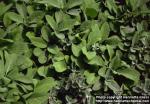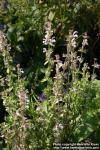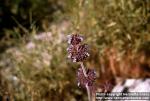Salvia (U. S. P.)—Salvia.

 Preparations: Compound Infusion of Sage
Preparations: Compound Infusion of Sage
The leaves of Salvia officinalis, Linné.
Nat. Ord.—Labiateae.
COMMON NAMES: Sage, Garden sage.
ILLUSTRATION: Bentley and Trimen, Med. Plants, 206.
Botanical Source.—Salvia officinalis, or Garden sage, is a plant with a pubescent, 4-sided stem, with erect branches, hoary with down, leafy at the base, those bearing flowers 1 foot or 1 ½ feet long, and tomentose. The leaves are opposite, entire, petioled, ovate-lanceolate, crenulate, rugose, the lowermost being white with wool beneath. The flowers are blue, in whorls, and in long, terminal, nearly simple racemes; whorls few-flowered, and distinct; floral leaves or bracts sessile, ovate, acuminate, membranous, and striated at the base. The calyx is campanulate, membranous, colored, striated, downy, and bilabiate; the upper lip 3-toothed; the lower bifid; and all the teeth subulate and acuminate. The corolla is 2 or 3 times as long as the calyx, with a large projecting tube, ringed in the inside, and bilabiate; the upper lip is arched, the lower one tri-lobed, the lateral lobes being reflexed. The stamens are affixed to short pedicels transversely about their middle (L.—W.).
History, Description, and Chemical Composition.—Sage is a native of southern Europe, and has been naturalized in this country as a garden plant; the leaves and tops should be gathered and carefully dried during its flowering season, which is in June and July. As described by the U. S. P., the leaves are "about 5 Cm. (2 inches) long, petiolate, ovate-oblong, obtuse or subacute at the apex, rounded or somewhat heart-shaped at the base, finely crenulate, thickish, wrinkled, grayish-green, soft-hairy, and glandular beneath; odor aromatic; taste aromatic, bitterish, and somewhat astringent"—(U. S. P.). The odor and aromatic taste of sage are due to its volatile oil. Sage imparts its virtues to boiling water in infusion, but more readily to alcohol. The infusion becomes black on the addition of sulphate of iron, which is due to the presence of tannin. Oil of sage is obtained by distilling the leaves with water; the yield from Dalmatian leaves ranges from 1.3 to 2.5 per cent. Oil of sage is "a yellowish or greenish-yellow liquid, having the penetrating, characteristic odor of sage. Specific gravity, 0.915 to 0.925; optically dextrogyrate. The oil contains small amounts of pinene and cineol, but its chief constituent (50 per cent) is thujone (C10H16O) (formerly termed salviol), which also occurs in the oils of thuja, tansy, and wormwood" (Prof. Power, Descrip. Cat. of Essential Oils and Org. Chem. Preparations, 1894; also see Gildemeister and Hoffmann, Die Aetherischen Oele, 1899).
Action, Medical Uses, and Dosage.—Sage is feebly tonic, astringent, expectorant, and diaphoretic, and has properties common to aromatics. An infusion is beneficial in flatulence connected with debility, and will, when the skin is soft and relaxed, the extremities cold, and the circulation enfeebled, prove efficient in restraining exhausting sweats. Should the sweating be preceded by hectic fever, and dry harsh skin, it is less likely to prove beneficial. The infusion may be taken cold throughout the day; it may likewise be used warm, as an anthelmintic, and for the purpose of causing diaphoresis in some febrile diseases. The warm infusion will cause active diuresis by checking its diaphoretic tendency. Dr. James Anton, of Lebanon, Ohio, considered it an excellent remedy for spermatorrhoea; also a valuable anaphrodisiac to check excessive venereal desires. It may be used in connection with moral, hygienic, and other aids, if necessary. Van Swieten stated that a vinous infusion forms an excellent fomentation to the breasts, when it is desirable to cheek the flow of milk. The infusion, either alone or combined with vinegar, honey, alum, or sumach berries, is much used as a gargle for inflammation and ulceration of the throat, and relaxed uvula. The oil may be used in small doses as a carminative and stimulant; and externally, applied with friction in rheumatism. Dose of the infusion, from 2 to 4 fluid ounces, 3 or 4 times a. day; of the powdered leaves, 20 to 30 grains. A strong tincture (℥viij to alcohol, 76 per cent, Oj) may be given in from 1 to 60 drop doses.
Specific Indications and Uses.—Skin soft and relaxed; extremities cold, and circulation enfeebled; colliquative sweating; urine of low specific gravity.
 Related Species.—Numerous other species of Salvia have similar properties, as the S. sclarea, or Clarry, a native of southern Europe, which is said to be antispasmodic and balsamic. The foregoing and S. pratensis, Linné, have been official in Europe. S. Horminum, S. bengalensis of India, S. pomifera of Greece, etc., have also been used. The seeds of S. verticillata and S. verbenacea are mucilaginous.
Related Species.—Numerous other species of Salvia have similar properties, as the S. sclarea, or Clarry, a native of southern Europe, which is said to be antispasmodic and balsamic. The foregoing and S. pratensis, Linné, have been official in Europe. S. Horminum, S. bengalensis of India, S. pomifera of Greece, etc., have also been used. The seeds of S. verticillata and S. verbenacea are mucilaginous.
Salvia lyrata, Linné, variously named Wild or Meadow sage, Lyre-leaved sage, or Cancer-weed, is a perennial plant, growing from Canada to Florida in shady woods and meadows, and flowering in May and June. It has an erect, quadrangular, nearly leafless stem, 1 or 2 feet high, branching and covered with hairs pointing downward. Radical leaves obovate, lyre-shaped or sinuate-pinnatifid, sometimes almost entire, and petiolate; cauline leaves mostly, but 1 or 2 pairs, just below the raceme, smaller and narrower than the radical. Flowers blue, in loose and distant whorls of about 6, forming a long, interrupted raceme; bracts oblong-linear, not longer than the calyx. Upper lip of the blue-purple pubescent corolla, short, straight, not vaulted; tube much exserted (W-G.). The fresh radical leaves will, it is positively asserted, when bruised and applied to warts, generally destroy them; the application to be continued for a day or two, and renewed every 12 hours. It is also reputed to have cured cancers, hence one of its names.
Salvia lanceolata, Willdenow, or Rocky Mountain sage, is reputed diaphoretic and diuretic, and is employed domestically in the eruptive, malarial, and rheumatic fevers.
 CHIA SEEDS.—The seeds of some Mexican species are known as Chia seed. The true chia seed is yielded by Salvia polystachya, Ortega (Salvia Chian, La Llave). These seeds are used in sweetened decoction by the Mexicans for sore throat, fevers, etc., and the cold decoction is applied to inflamed eyes. The fruit of Salvia Columbarae, Bentham, is also known as Chia seed (Gray and Rothrock).
CHIA SEEDS.—The seeds of some Mexican species are known as Chia seed. The true chia seed is yielded by Salvia polystachya, Ortega (Salvia Chian, La Llave). These seeds are used in sweetened decoction by the Mexicans for sore throat, fevers, etc., and the cold decoction is applied to inflamed eyes. The fruit of Salvia Columbarae, Bentham, is also known as Chia seed (Gray and Rothrock).

